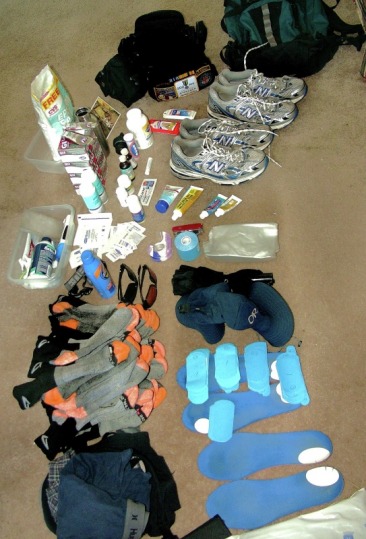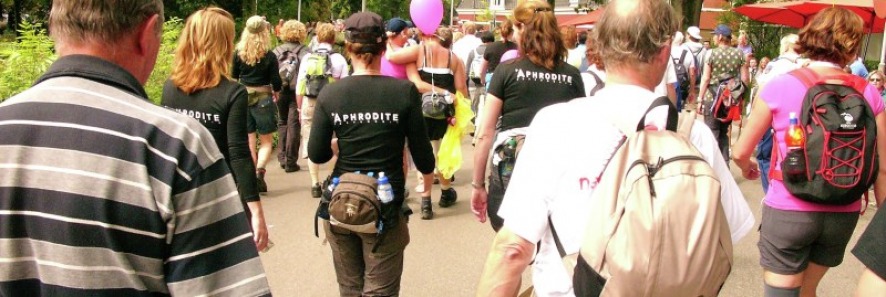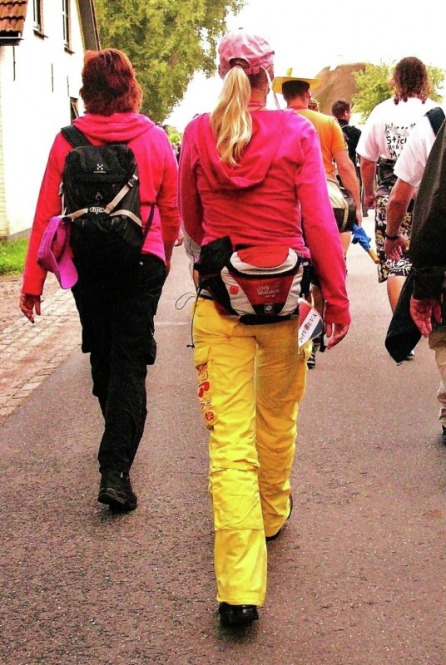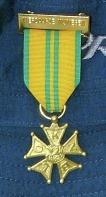The 4 Day Nijmegen March and how to accomplish it.
~Gear~
You will need whatever it takes to operate completely independant through the entire day.
What you'll need, from my experience.
Each marcher arranges their own selection of personal gear to get through the day. Some get by on 1 pair of socks in leather walking shoes and only a canteen. My skin type does not allow such ease, but I worked around it. If you are prone to skin blisters hiking, this information will prove valuable to you.
The following is a list of items I used on the 120 mile course for 4 days to achieve success, not 1 new blister at the event.
In order to prevent skin damage over a course of 11-12 hours of walking, protective tape and blister plasters can help.(be sure and get Kinesio tape)
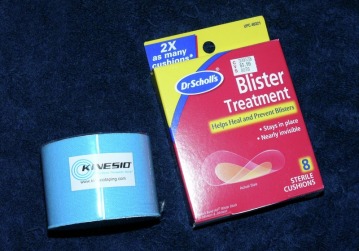
These products need to be used in concert with several other products as they alone cannot totally prevent blistering. Even worse than lymph blisters are blood blisters which go deeper and take longer to heal.
Left: Kinesio text tape, cut custom to fit the foot, paper backed, water resistant, flexible medical grade tape.
Right: Blister plasters to add protection on the heel, under the tape.
Left: Kinesio text tape, cut custom to fit the foot, paper backed, water resistant, flexible medical grade tape.
Right: Blister plasters to add protection on the heel, under the tape.
Anywhere on your foot you experience a hot spot, these plasters may prevent an actual blister from occuring.
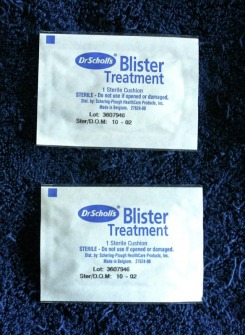
I use these as a standard on my heel every time I walk over 16 miles. There seems to be something about a distance of 16 miles or 4 hours walking that brings about the risk of blisters forming. The old saying "Awe comon, you're feet'll toughen up" is a misnomer. Blisters form from from rubbing in combination with heat & moisture. What takes place is a de-lamination of skin layers. Sweat soaked hot feet going down a steep hill may blister under thick callouses no matter what you did or how long. Most people who put out that cliche' in regards to feet never walked more than a couple hours at a time, where no problem would ever show up in well fitted shoes.
Athlete foot powder, Swiss Army knife & Tincture of Benzoine. Musts in your care kit.
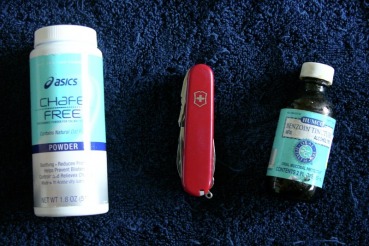
Powder will keep your feet dryer, get a good athlete brand or anti-fungal, anti-athletes foot brand to prevent any problems that result from 25+ all day long distance marches to prepare for the 4 Day in Nijmegen. The Swiss knife is critical for shoe modification and blister treatment snipping the side of it open after sterilizing it with alcohol. Tincture of Benzoine is a medical adhesive used to help make tape and bandages stick better. You'll need this during sock changes after treating any blisters to re-attach the tape.
Quality shoes...don't settle for less than the best...you'll be walking over 600 miles to prepare and accomplish the event. These are New Balence NB 1063, an excellent choice in 2009, currently replaced by the 1064 model. (slightly stiffer)
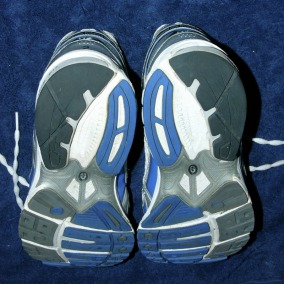
These shoes covered over 500 miles on concrete, asphalt, dirt, cobblestone, ice & snow. They have even heel wear and I bought 2 pair to rotate so if it rained one day I would still have a dry pair to wear. In 2009, it rained 7 hours on day 3 of the march. These quality shoes still have tread left after a year and a half! I place each step mindfully, picking my feet up...after all, to complete the event...each foot will take about 330,000 steps for 200 kilometers. Dragging your feet or stepping sloppy will cause knee or hip injury...whatever you do wrong in 1 foot step, it will be multiplied 1/3 of a million times per foot to cross the finish.
*how those guys do it in boots is amazing, leather doesn't breath. I did a 50km training day in boots just to 'put myself in thier shoes,' very wet, lots of blisters
*how those guys do it in boots is amazing, leather doesn't breath. I did a 50km training day in boots just to 'put myself in thier shoes,' very wet, lots of blisters
Getting the right shoes Pronation correctly diagnosed= make or break the event.
Discover what your pronation is on this web page...
http://www.runnersworld.com/article/0,7120,s6-240-319-327-7727-0,00.html
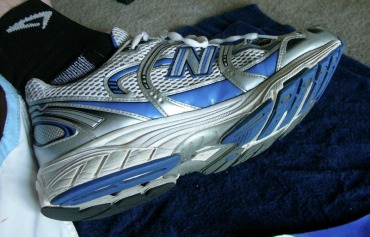
Warning:
Have a professional shoe salesman or Podiatrist determine your 'pronation.'
Not doing so...you can suffer knee injuries from having your ankle tilting inboard or outboard. I have neutral pronation and was sold the wrong shoes..too small and wrong pronation. The salesman and personal trainer I was going to for advice steered me into a variety of injuries that nearly cost me the event and cost $500.00 in useless equipment.
In my case ---> John Vonhof to the rescue...
Ultra-Marathon Runner - you can trust.
Get his book called "Fix Your Feet." He pulled me back on track and salvaged all my efforts.
Johns link: http://www.fixingyourfeet.com/
Do not argue with inexperienced salesman or personal trainers who claim to 'know it all' and will side line you to make a buck and move excess inventory...get Johns book - A Must!
Have a professional shoe salesman or Podiatrist determine your 'pronation.'
Not doing so...you can suffer knee injuries from having your ankle tilting inboard or outboard. I have neutral pronation and was sold the wrong shoes..too small and wrong pronation. The salesman and personal trainer I was going to for advice steered me into a variety of injuries that nearly cost me the event and cost $500.00 in useless equipment.
In my case ---> John Vonhof to the rescue...
Ultra-Marathon Runner - you can trust.
Get his book called "Fix Your Feet." He pulled me back on track and salvaged all my efforts.
Do not argue with inexperienced salesman or personal trainers who claim to 'know it all' and will side line you to make a buck and move excess inventory...get Johns book - A Must!
"Oh comon, you're feet aren't that big, you're wearing the wrong sized shoes!"
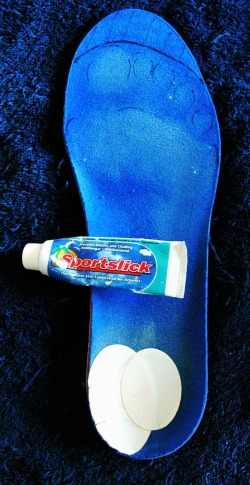
In one respect, these shoe salesmen are correct, if they were dress shoes.
For long distance marching your feet swell and you'll need a size 1.5 too big in length and 1.5 too big in width (may vary in your case - experiment, but expect to buy oversized) or you will experience extensive blistering, bursitis and other foot injuries. Note the wearing pattern I highlighted in marker, defining my foot.
I ask myself "Who has feet shaped like this shoe??"
I needed to buy something way too long to get the shoes wide enough. The wear says it all.
The tube is "SportsSlick," very useful in eliminating heat generating friction or already formed hot spots, it is applyed to the friction reducing decals (white) known as "Engo Guards."
For long distance marching your feet swell and you'll need a size 1.5 too big in length and 1.5 too big in width (may vary in your case - experiment, but expect to buy oversized) or you will experience extensive blistering, bursitis and other foot injuries. Note the wearing pattern I highlighted in marker, defining my foot.
I ask myself "Who has feet shaped like this shoe??"
I needed to buy something way too long to get the shoes wide enough. The wear says it all.
The tube is "SportsSlick," very useful in eliminating heat generating friction or already formed hot spots, it is applyed to the friction reducing decals (white) known as "Engo Guards."
Aftermarket insoles, will be needed to accomplish the march that are softer foam and generate less heat.
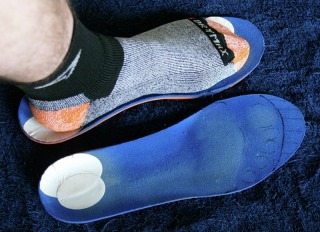
I needed to go through 4 brands and types of orthotics and inserts until I found one that worked. The best one reduced blistering and fatigue significantly. Every company changes their designs and materials annually, so watch for that...if you like something now, stock up!
The apparent "room in my shoe" is to allow for swelling after 50 hours of walking on cement within only 3.5 days carrying 20 pounds.
See what happens if you don't go oversized...it will feel like your wearing shoes 2 sizes too small, fresh out of the oven with your feet skinned - not nice at all.
The apparent "room in my shoe" is to allow for swelling after 50 hours of walking on cement within only 3.5 days carrying 20 pounds.
See what happens if you don't go oversized...it will feel like your wearing shoes 2 sizes too small, fresh out of the oven with your feet skinned - not nice at all.
Fit your aftermarket insoles, vent your shoes, lace pattern & guard all rough edges.
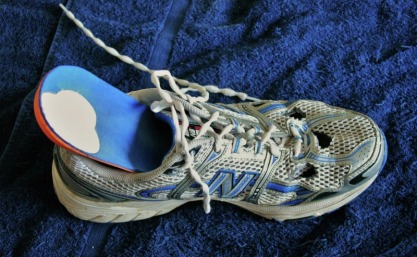
Strategies to eliminate injury include carefully fitting the insole to the perimeter, even on the bottom as every small bump and twist will hot spot your foot after 6 hours. Another tactic that works against moisture is to cut vent openings on the webbing area, not the support area.
Lace patterns will also custom fit your shoe to your foot, holding it down wherever it may move.
Engo guards will work well inside the shoe and on the insole.
*To avoid any "roll up," use Weldwood (glue bottle) contact cement as an additional hold down adhesive after the Engo's get wet...contact cement is totally waterproof.
*The new white Engos roll up and curl off after immersion...the blue type from 2008-2009 did not, they were waterproof.
Lace patterns will also custom fit your shoe to your foot, holding it down wherever it may move.
Engo guards will work well inside the shoe and on the insole.
*To avoid any "roll up," use Weldwood (glue bottle) contact cement as an additional hold down adhesive after the Engo's get wet...contact cement is totally waterproof.
*The new white Engos roll up and curl off after immersion...the blue type from 2008-2009 did not, they were waterproof.
Getting the right socks...I went through 5 different brands before I found 'Drymax."
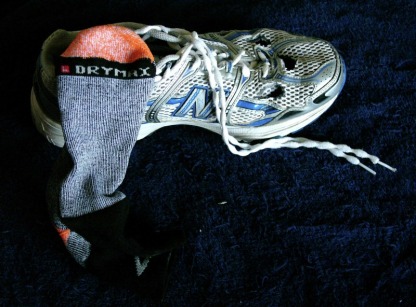
'Drymax (orange tip) athletic socks are about the worlds best trail running socks. Recommended to me by John Vonhof, these socks carried me across the finishing line in 2009. I carried 6 pair a day for sock changes. Sock changes instantly cool the feet by 10 degrees or more and when it's 90+ outside, you'll appreciate that a lot. This reduces the forming hot spots or stops them from forming. Others may puzzle at your unique socks, but nothing on the market drys faster and this helps reduce your enemy - moisture.
* I found I was allergic to 'coolmax fiber.' It made extensive cappilaritis all over my lower leg. One health care professional said '"Oh...you are just getting,,,old." Not true at all...all signs of capplilaritis were eliminated when I started wearing socks with 'drymax' fibers.
* I found I was allergic to 'coolmax fiber.' It made extensive cappilaritis all over my lower leg. One health care professional said '"Oh...you are just getting,,,old." Not true at all...all signs of capplilaritis were eliminated when I started wearing socks with 'drymax' fibers.
After practice, after march soaks, 10 minutes in epsom salts.
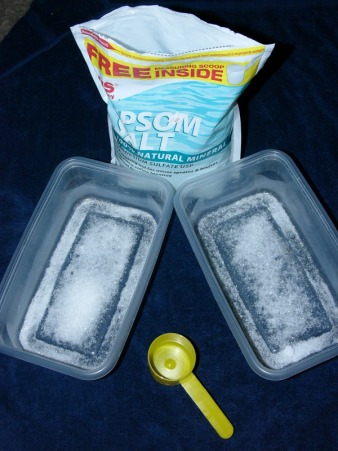
You'll want to place a large scoop of epsom salt in each foot pan (I used zip lock food storage pans) and some ice to soak for 10 minutes. GET READY: That dunk in cold salt water doesn't feel so good at first...any open blister will burn from the salt.
You should be close to a shower or bath to rinse it off if it gets to be too much. 10 minutes soaking, then air dry...let the salt soak in. I usually eat my dinner at this time since I'm stationary anyway...picking it up on the way home.
You should be close to a shower or bath to rinse it off if it gets to be too much. 10 minutes soaking, then air dry...let the salt soak in. I usually eat my dinner at this time since I'm stationary anyway...picking it up on the way home.
Sanding & moisturizing to keep skin supple.
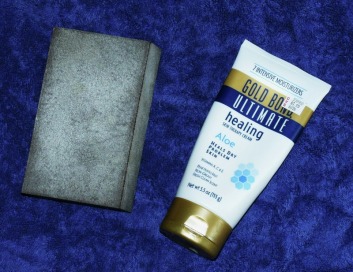
People with no experience in long distance marching immediately assume that thick leathery feet, gained by walking barefoot on cement is the magic cure to prevent any foot injury. Not true at all...it's the opposite. Hard leathery stiff skin is prone to deep level blisters which are difficult to drain. My success in 2009 came as a result of reading about a procedure to keep skin pliable and moist, thus reducing friction and blistering.
The technique I used which worked perfectly is to use a foam drywall sanding block (from Home Depot) to reduce all thick yellowed skin after it dried from an epsom salt soak. The epsom salt hardened my skin after a soak, making it easier to sand. Then before bed, cover your feet with 'Gold Bond healing' lotion and place a plastic bag over them if they were too dry, (so none of the lotion would rub off too soon.)
It is not necessary to go in and get 'pedicures' and use womens products guys, which is a cosmetic treatment anyway and wouldn't help as much for sport training...(girls should go for that if they like)...but all you want to do here is reduce the heavy skin produced from walking hundreds of miles and keep it supple so it doesn't blister and if it does, it is easy to treat.
,
The technique I used which worked perfectly is to use a foam drywall sanding block (from Home Depot) to reduce all thick yellowed skin after it dried from an epsom salt soak. The epsom salt hardened my skin after a soak, making it easier to sand. Then before bed, cover your feet with 'Gold Bond healing' lotion and place a plastic bag over them if they were too dry, (so none of the lotion would rub off too soon.)
It is not necessary to go in and get 'pedicures' and use womens products guys, which is a cosmetic treatment anyway and wouldn't help as much for sport training...(girls should go for that if they like)...but all you want to do here is reduce the heavy skin produced from walking hundreds of miles and keep it supple so it doesn't blister and if it does, it is easy to treat.
,
Pain relief, it comes on around the 20 mile mark with me, these help a lot.
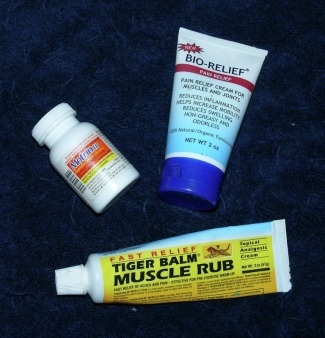
Motrin 200mg Ibuprofin, Muscle cream and aspirin based 'Bio-Relief' all served me well when fatigue got distracting.
Not usually needed until the final 15 kilometers or hour of the day. None of these is considered 'doping.' (unlike steroids)
I will not 'sugar coat' this event...you will hurt....badly, and every bit of 'mind over matter' will power you have will be needed to finish...not only to beat pain - but the monotony of training such long distances in ice/snow/rain/cold/sweltering heat and occasionally you'll be lucky to have a pain free (blister/fatigue free) nice day during the 5 months prep training work...enjoy those! These products help you get through a lot.
Not usually needed until the final 15 kilometers or hour of the day. None of these is considered 'doping.' (unlike steroids)
I will not 'sugar coat' this event...you will hurt....badly, and every bit of 'mind over matter' will power you have will be needed to finish...not only to beat pain - but the monotony of training such long distances in ice/snow/rain/cold/sweltering heat and occasionally you'll be lucky to have a pain free (blister/fatigue free) nice day during the 5 months prep training work...enjoy those! These products help you get through a lot.
Anti-chafing, you won't know you'll need it until it's too late.
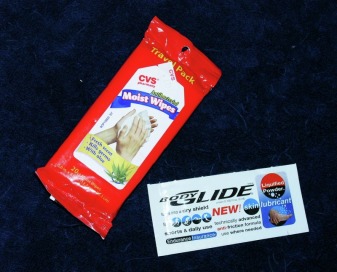
When out on the course, these 2 products here are your restroom items. Clean yourself thoroughly with the wet-naps and then apply the 'body glide' anti-chafe' powder lotion pack. You will not get chafed if you do this as all the salt crystals will fail to form.
Skip this step? (sandpaper your crotch with 80 grit sandpaper and salt it down to know how bad chafing feels after 30 miles, walking 10-11 hours in 95 degree sunny weather)...very unpleasant.
It only takes 1 time to learn that lesson...you'll know it happened after you're home when the shower water hits you.
Skip this step? (sandpaper your crotch with 80 grit sandpaper and salt it down to know how bad chafing feels after 30 miles, walking 10-11 hours in 95 degree sunny weather)...very unpleasant.
It only takes 1 time to learn that lesson...you'll know it happened after you're home when the shower water hits you.
Sun protection - a must since you'll be out there all day long every day for 4 days and training.
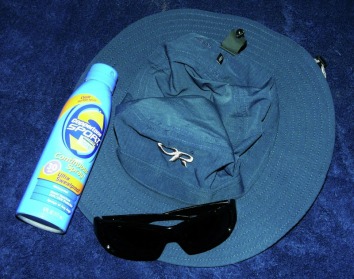
Have good sunglasses not for style but with true uva/uvb blockage, wear a light breathable sun hat to stop the heat on your head but still allow heat to rise away and bring some sweatproof spf 30 sun spray. This is a quick storable no mess way to block the sun with no 'missed spots.' Lotions and creams are messy on hands (if your using a nice camera) and can leave patches of un-protected skin when done in haste.
Additional needed items include a headlight, rain pants and knee brace.
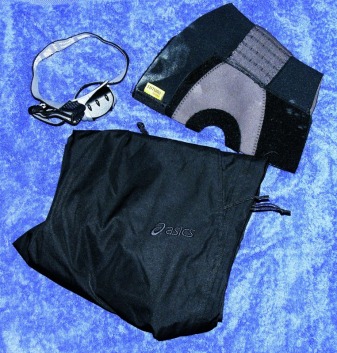
Depending on your schedule, you may find yourself training in the dark and this is where a runners headlamp is needed. If rain comes and it's getting cooler outside, have rain pants to wear to prevent chilling and coming down with something during the event. The knee brace is useful if the sidewalk in the area you walk becomes tilted or uneven. Traveling over 120+ miles of unfamiliar surface will test you constantly.
Custom gear belt, something you can assemble easily at the Army/Navy stores.
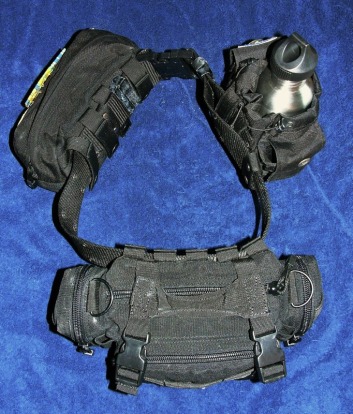
I found that 'Camel backs' and backpacks severly limit ventilation to my back, making it totally soaked with sweat and causing a heat rash over the 50 hour event.
The waist belt eliminates this problem and when balenced, you don't even feel it on.
An added bonus is that the canteen is right there in front easy to get and the front pouches do not interfere with the swing of your arms.
There is enough room for everything in this set up. Socks, medicine, tape, water, band aids, lotion, sunspray, gu energy packs...all fits without a problem.
The canteen is removable unlike camel backs and can be filled from a variety of sources, dishwasher safe stainless and can hold 'vitamin water or even orange juice without a cleaning problem.
*The canteen cap is a 'no drop' version...no fun dropping a cap in a crowd of hundreds of fast moving feet and if you drop it, your valuable water will splash out and you'll get too thirsty to finish.
**Weight loaded: about 18-19 pounds.
The waist belt eliminates this problem and when balenced, you don't even feel it on.
An added bonus is that the canteen is right there in front easy to get and the front pouches do not interfere with the swing of your arms.
There is enough room for everything in this set up. Socks, medicine, tape, water, band aids, lotion, sunspray, gu energy packs...all fits without a problem.
The canteen is removable unlike camel backs and can be filled from a variety of sources, dishwasher safe stainless and can hold 'vitamin water or even orange juice without a cleaning problem.
*The canteen cap is a 'no drop' version...no fun dropping a cap in a crowd of hundreds of fast moving feet and if you drop it, your valuable water will splash out and you'll get too thirsty to finish.
**Weight loaded: about 18-19 pounds.
Lightweight folding chair, very handy when no seating is available.
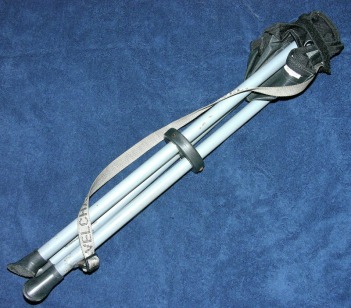
Sitting on the cold pavement is a bad idea, cooling off warm muscles. When it rains, no dry ground exists. In big crowds, all the seats are taken...what's the solution? Bring your own chair...this one was $25 and very useful for sock changes!
Folding umbrella, lightweight.
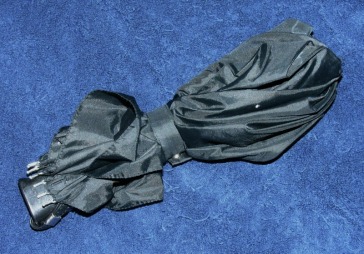
This is ideal for light rainshowers when a poncho would get too hot. Easily mounts on a small pack.
Light breathable moisture wicking clothes & rain poncho.
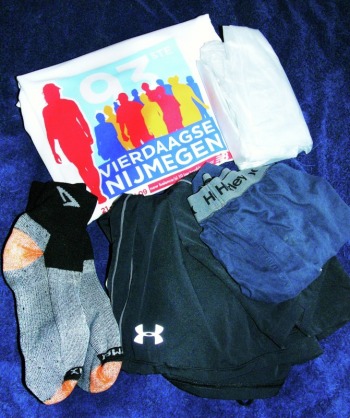
You'll want light breathable fabrics for your shirts, shorts and underwear.
Your clothes need to be light and non-chafing that pull moisture away from you.
May as well be dry, comfortable and avoid overheating if you have some control over that.
Most everything you need is available at specialized running shops like 'Runnin' Gear' or 'Hansens.'
Durable clear ponchos will allow your vision to continue as you put it on. No sense putting on a dark colored one in a crowd since you are unable to see anyone around you. You can put a clear one on while walking, unlike olive green ones. Have one folded under your spare socks in case of a down pour.
*Keep zip lock bags in case of rain too to protect your dry socks till the rain stops.
Your clothes need to be light and non-chafing that pull moisture away from you.
May as well be dry, comfortable and avoid overheating if you have some control over that.
Most everything you need is available at specialized running shops like 'Runnin' Gear' or 'Hansens.'
Durable clear ponchos will allow your vision to continue as you put it on. No sense putting on a dark colored one in a crowd since you are unable to see anyone around you. You can put a clear one on while walking, unlike olive green ones. Have one folded under your spare socks in case of a down pour.
*Keep zip lock bags in case of rain too to protect your dry socks till the rain stops.
After march soft sandals or 'flip flops.' You'll need this because shoes are the last thing you'll want to be wearing.
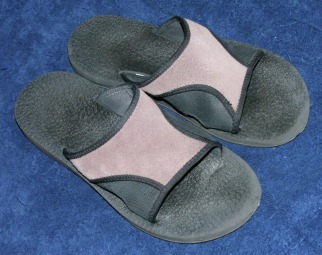
Get sandals or flip flops that have enough cushion to provide support, especially if you are an international traveller and have to walk extensive distance down airport hallways.
